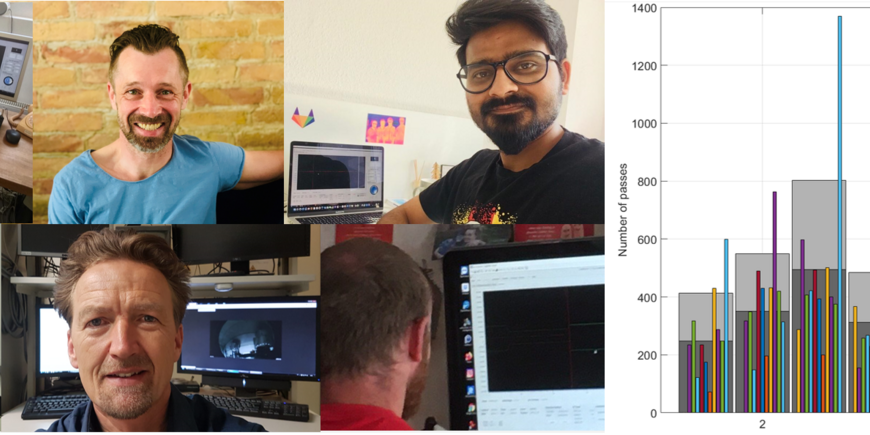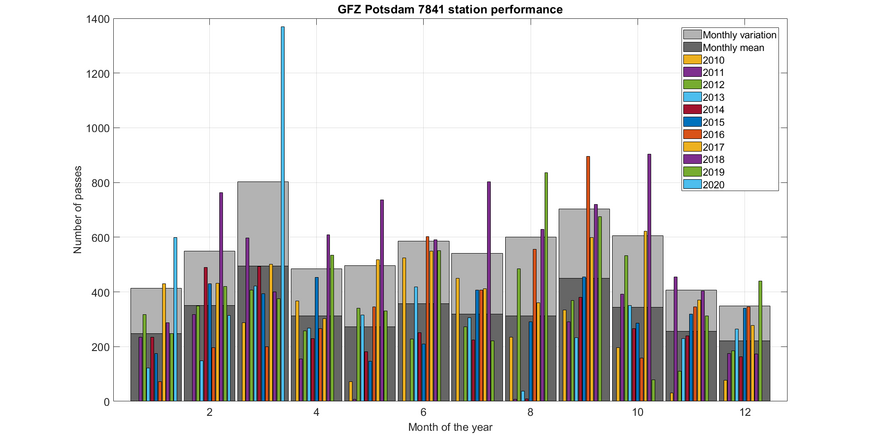At GFZ, in times of the Corona crisis, the majority of the staff works in home office. Except for a minimal on-site operation to secure services such as the GEOFON earthquake monitor, contacts among each other should be reduced to slow down the spread of the virus. However, digitalization allows important monitoring tasks to be continued remotely.
In the Satellite Laser Ranging Station SLR the orbits of satellites are determined by laser. These orbits are monitored and parameters such as the Earth's rotation or deformations of the Earth's surface can be derived. About two years ago, the observatory was modernized and since then it can be remotely controlled, which now allows operation from the home office.
The station depends on clear visibility for its measurements, clouds block the laser's path towards a satellite. A period of good weather from 21 March onwards coincided roughly with the start of the switch to minimum operation at GFZ. This and the fact that the technical staff of the observatory is currently unable to work in their workshops and supports the monitoring work of the station from home office made a new measurement record possible: Within one week the orbits of almost 600 satellites were observed, which is already above the usual monthly average. In the whole month of March, almost 1,400 passes were observed, while the monthly average is usually only about 500 passes.
Sven Bauer, head of the SLR station: “We are all very happy that we were able to benefit from the good weather conditions in the home office despite all the restrictions during these difficult times. Without the support of the whole team and the help of our technical staff this would not have been possible".
As a result of the corona crisis, five of only about 15 SLR stations worldwide have failed. This makes the work of the remaining stations, including the observatory on Potsdam Telegrafenberg, all the more important. Only the continuous provision of data can ensure that the geodetic measurements derived from the distance measurements from ground station to satellite remain available. Besides the orbits of the satellites geodetic parameters of the Earth, such as the position of the centre of the Earth or the length of the day, are determined. These parameters go into so-called reference frames, without which positioning by means of GNSS satellites, i.e. also navigation by GPS, would be impossible. (ak)









![[Translate to English:] Torsten Sachs in front of a climate station on a field](/fileadmin/_processed_/3/9/csm__TorstenSachs_bearbeitet_GS_4a1365ef84.jpeg)

![[Translate to English:] left image flood at the Ahrtal: image from above, several houses are flooded; left image:: Heidi Kreibich;](/fileadmin/_processed_/4/4/csm_Bild2_9af0130e9f.png)



![[Translate to English:] Start der Vega Rakete](/fileadmin/_processed_/6/4/csm_20231201-kachel_Vega-VV23-launch_ESA-CNES-Arianespace_706716b68c.jpeg)









![[Translate to English:] Poster exhibition at the Brandenburg Hydrogen Day at the GFZ, some participants in the foreground](/fileadmin/_processed_/6/5/csm_Erster_Brandenburgischer_Wasserstofftag_GFZ_402fcec95e.jpeg)
![[Translate to English:] Group picture of the participants](/fileadmin/_processed_/9/4/csm_20231108_CAWa-Workshop-Tashkent_Gruppenbild_99ea779d8a.jpeg)

![[Translate to English:] [Translate to English:] Hörsaal](/fileadmin/_processed_/e/6/csm_H%C3%B6rsal_e21ac645fb.jpeg)


![[Translate to English:] The Delegations in the Historic Library on the Telegrafenberg. In the back there are from left to right, the Dutch Ambassador for Germany, Ronald van Roeden, the Dutch Minister for Education, Culture and Science, Robbert Dijkgraaf and the scientific director of the GFZ, Susanne Buiter.](/fileadmin/_processed_/d/b/csm_Kachel-2_9eba4b4212.jpeg)

